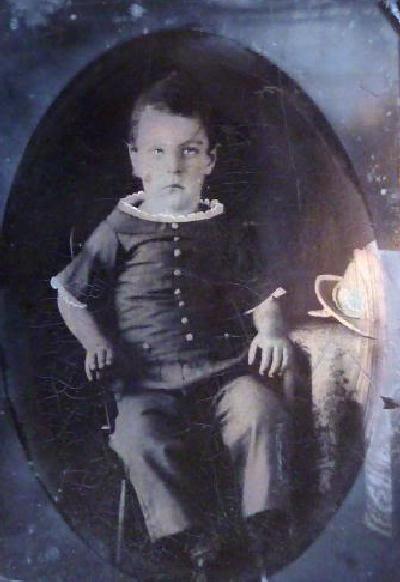
Figure 1.--This early tin-type was made for an oval frame. It is undatedm but looks like the 1850s to us. The boy wears an open-neck blouse Notice the waist buttons. |

|
We notice blouses commonly worn in the mid-19th century. Some were covered by suir jackets, but jackets were not as common in the 50s as was the case in the rest of the century. We can make out some details in the photographic record. Generally the collars were realatively small--sometimes so small that they can barely be seen. There were a wide variety of collar styles. Younger boys might wear blouses wihout collars, but sewed on frills. The tintype here is a good example (figure 1). We also notice sleeves that balloon out worn with jackets that were cut below the elbows. A good example is the blouse worn by an unidentified boy in the mid- or late-1850s. They did not blouse out like the blouses of the 1880s. The term blouse was we think not yet used. We note many f these garments done with button styling. Other blouses just hung down and were not employed in holding up psnysd. Tunics were also popular at the time. It is often difficuklt to destinguish between tunics and blouses, in part because so many photographs at the time primarily showed the subjects torso.
We notice blouses commonly worn in the mid-19th century. Some were covered by suit jackets, but jackets were not as common in the 50s as was the case in the rest of the century. Here a factor was economics. America before the civil war was still very rural and incomes for most of the poulation still very limited. While the sewing machine was invented (1846), most gaments were still hand sewn and this relatively expensive. Thus many boys did not wear or even have suit jackets. Boys might wear blouses under their suit jackets, but many boys wore blouses without jackets. Age was a factor here. Younger boys were less likely to wear jackets. Social class was another factor. The more affluent the family, the more likely it would be to wear a jacket.
We can make out some details in the photographic record. Generally the collars were realatively small--sometimes so small that they can barely be seen. There were a wide variety of collar styles. Younger boys might wear blouses without collars, but with sewed on frills. The tintype here is a good example (figure 1). Most blouses were done with long sleeves rnding in cuffs like modern shirts. We also notice sleeves that baloon out worn with jackets that were cut below the elbows. A good example is the blouse worn by an unidentified boy in the mid- or late-1850s. They did not blouse out at the waist like the blouses of the 1880-1900s. The term blouse was we think not yet used. What we can not tell from the ophotographic record is if these garments had shirt tails. We think they did not which is why we classify them as blouses rather than shirts or shirt waists. We note large numbers of blouses done as nutton-on garments to hold up pants. Thus suspenders or belts were not very common.
We note many of these garments done with button-on styling. Other blouses just hung down and were not employed in holding up pants. We see two basic types of blouses. Some of the blouses worn by younger boys look like dress blouses. Other blouses looked more liike shirts, but had a wide variety of collars, albeit rather small collars. We are not entirely sure what these garments wwere called. The blouses worn by boys were much more varied than what we see later in the century, in part because ready-made clothing was not yet very important. We see many blouses with low neck-line styling. This was the same neck styling used on dressed. The necks were over setailed with wgat looks like lace or ruffles. We also notice short sleeves. This was a style common on dresses, but shirts were not done with short sleeves. A good example is an unidentified boy in the late-19th century. Like the neckline, the ends of the shorts sleeves were also trimmed.
We notice boh white and solid collored blouses. We also see patterned blouses. Plaid was ay popular pattern in the 1850s. A good example is an unidentified boy in the late-19th century.
We do not yet have a good idea of the age of boys wearing blouses. We note sharp differences in the blouses worn by different aged children. We note pre-school children wearing blouses that looked more like dress blouses. Boys by the time they reached school age or perhaps a little before were wearing blouses that looked more like shirts. We think that blouses were mostly worn by pre-teen boys, but we need to archive more images before we can assess age trends. It is a little duifficult to differentiate blouses and shirts because blouses were not yey blouced. Our initial assessment is thsat boys began wearing blouses as soon as they were breeched and begn to use plants.
We do not yet have a good idea about gender. We know that boys commonly wore blouses. We are not sure avout girls. Girls of course commonly wore dresses. But we know that some girls wore skirts. Here we are not sure hust wha girls wore as an upper garment with skirts. And to what extent that garment was differed with the blouses woirn by boys.
Tunics were also popular at the time. It is often difficuklt to destunguish between tunics and blouses, in poart because so many photographs at the time primarily showed the subjects torso.
Navigate the Boys' Historical Clothing Web Site:
[Return to the Main American 19th century blouse page]
[Return to the Main American blouse page]
[Introduction]
[Activities]
[Biographies]
[Chronology]
[Clothing styles]
[Countries]
[Bibliographies]
[Contributions]
[FAQs]
[Glossaries]
[Images]
[Links]
[Registration]
[Tools]
[Boys' Clothing Home]
